- How Do Cats Learn?
- Can Cats Be Motivated the Same Way as Dogs
- Why to Train Your Cat?
- Things You Should Know Prior to Starting the Training of Your Cat
- Simple Steps at the Very Beginning
- Train Your Cat To Use a Litter Box
- Crate Training a Cat
- Train Your Cat to Give a High Five
- Train a Cat to Come on Command
- Train Your Cat to Sit
- How to Address Bad Behaviors
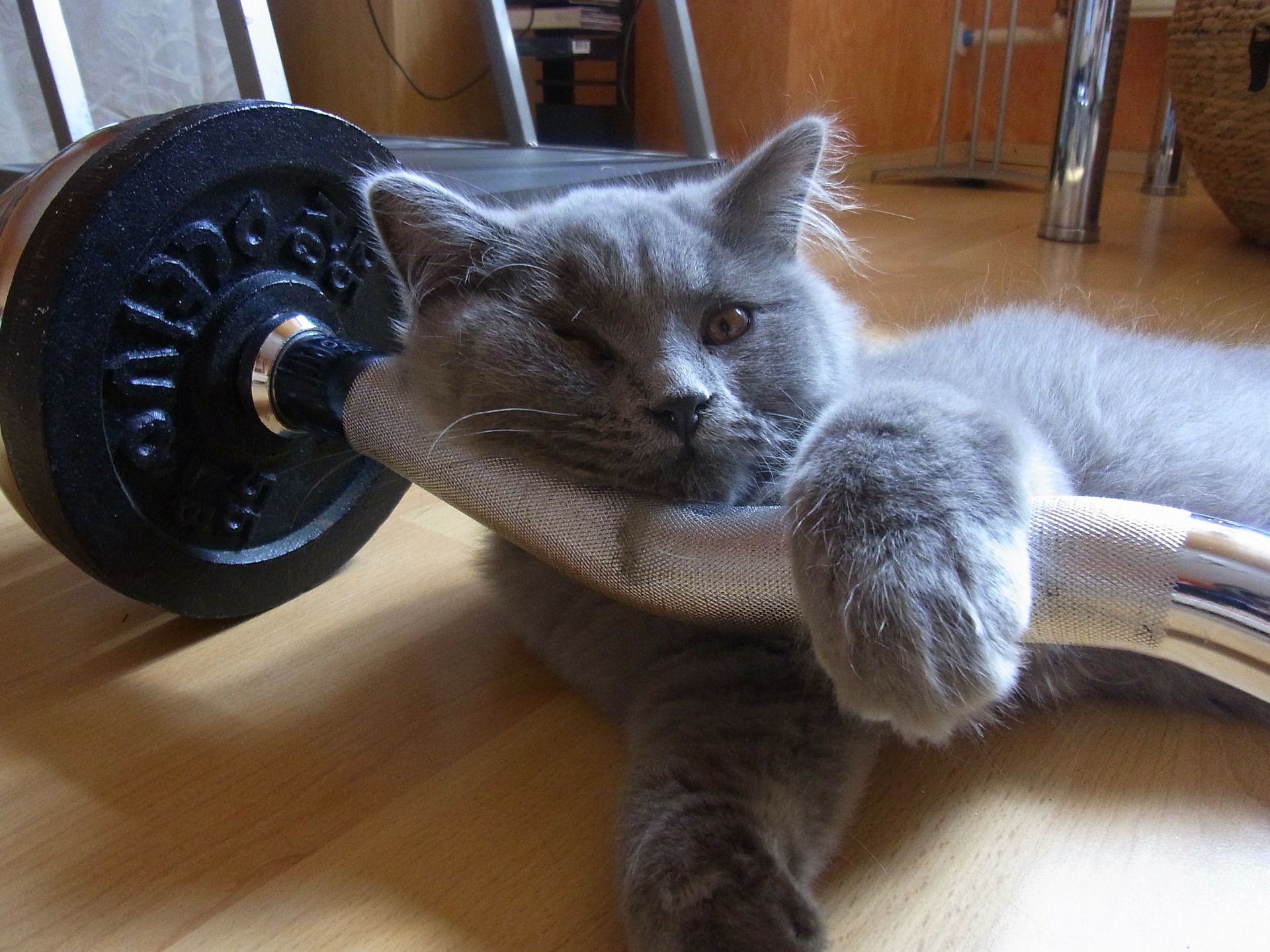
You are a cat parent, you are highly interested in cat training, or you just love cats- whatever the reason may be, you are here to learn more about cat training.
We will provide you with some basic principles that you should follow if you decide to take on the role of a cat trainer. We will also give you tips on how to teach your meowing paw friend some tricks and address common behavioral issues.
How Do Cats Learn?
Cats, as well as other species, learn based on the principle of association. The best way to apply this principle is to encourage your cat to do something that he/she will associate with a positive outcome. The better the cat feels after performing a certain behavior, the bigger the chance is for him/her to repeat it in the future.
Can Cats Be Motivated the Same Way as Dogs
When it comes to training, cats unlike dogs, are not so interested in pleasing us, respectively in reading our emotions. If your dog will genuinely enjoy being petted and praised, your cat is not likely to feel encouraged enough to do what you want him/her to, based on physical or verbal praising only. Cats are highly motivated by food, some of them are even quite picky and you may be unable to lure them with their regular food only, if you want them to perform a certain behavior.
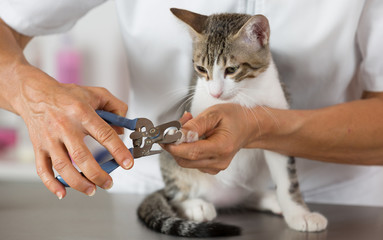
Why to Train Your Cat?
Many of you may think about cat training as a way to make your cat do tricks- give a paw, sit...etc.- funny, but unnecessary. Cat training can help you in different situations as you will be able to change your cat’s attitude towards a certain activity, that they initially feel uncomfortable with, i.e. grooming or cleaning his/her ears. Once your kitty starts associating a certain behavior/ activity with a positive feeling and an added reward to it, he/she will be more likely to want to do. Even if your cat still does not enjoy a certain activity, he/she is less likely to be anxious when this activity takes place.
Also, you can train your cat to come to you, or to go to a particular location like his/her crate. This could be very helpful in case you have to bring your cat to a veterinarian or prevent him/her from doing something potentially dangerous outside.
Things You Should Know Prior to Starting the Training of Your Cat
Know Your Cat Well
This step is crucial, as you should know what will motivate your cat, as well as what factors will discourage him/her. As I already mentioned above cats are primarily motivated by food. Certain types of toys (like those including feathers, wool, bells) as well as giving your cat access to places where he/she is not usually allowed, can be also used as tools for behavior management. However, food is considered primary positive reinforcement tool, so you should know your cat’s taste. A helpful tip that can be applied here is- the smellier, the better. Your cat will smell the treat first, before he/she decides whether it is worth it or not. Some feline friends are really picky while others are easy to be lured by any kinds of food.
Always Have Treats
Since you are still a beginner and your cat is not likely to have any training background, you should always have his/her favorite treats by your side. These treats should be highly valued by your cat so that he/she stays motivated during the training process. You can get some larger quantities of treats just in case to make sure that you will not run out of your kitty’s primary training motivator.
Prepare a Certain Area
This step may be helpful at the beginning of the training process as cats are very curious by nature and hardly remain focused on one object for a longer time. That is why you may need to set up a certain area in your home where all potentially distracting factors have been removed- no toys, food, smells, sounds, other animals or people…your cat should be encouraged to stay focused on you.
The Right Time
Since you already know your kitty, you are likely to know his/her daily routine as well- when he/she usually eats, plays, sleeps...You should implement the training sessions in your kitty’s routine, in a way that they will not disrupt it. Cats love to follow a certain pattern as, just like dogs, it makes them feel safe. The more predictable things are, the more confident and calmer your kitty is likely to be.
Frequent and Short Sessions
Long sessions are not recommend as cats can not stay focused for long periods of time. Small steps, leading to consistent progress, are more beneficial for the end result than long sessions, and desire for perfection.
Do Not Change the Cue Words / Hand Signals Used for the Commands
Once you chose a cue word for a certain command, it should remain the same. The language you will train your kitty in and the words that you will use do not affect the end result. It is important that you do not mix them, otherwise your kitty will get confused.
Involve Your Family Members in the Training Process
Let your family members know the cue words/signals and the commands they match. You should utilize the same approach when it comes to training.
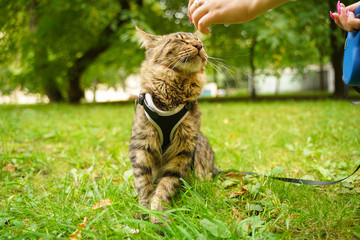
Use Positive Reinforcement
Never punish your cat. Punishment can only cause your cat to avoid you instead of correcting his/her behavior. Stick to positive reinforcement for behavior management- you will achieve the wanted results through encouragement of the wanted behavior and not through punishment of the bad one.
Do Not Train Your Cat Many Tasks at the Same Time
You may want to have a very obedient and well-mannered kitty and try to train him/her several tasks at the same time. Do not overwhelm and confuse your paw friend. You should move to the next command only after your kitty mastered the first one.
Be Patient and Consistent
Logically comes the next piece of advice- be patient! Always! Proper training requires patience and consistency. Small steps lead to big results.
Repeat Enough
When you notice that your kitty already mastered a certain task, do not consider its repetition for unnecessary. Each learned task should be regularly repeated, as repetition reinforces the wanted behavior.
Training Techniques
There are three common training methods that can be used separately or combined together. These are:
1. Voice commands;
2. Hand Signals;
3. Clicker Training.
Voice Commands
Voice commands mean that you will say a certain cue word, that will be associated by your cat with a certain behavior. A simple example representing the use of voice commands is the word “sit”, that you can use just a moment before your cat’s but touches the ground. Once he/she sits, you should reward him/her immediately.
Hand Signals
You can use hand signals as well. Researches have been made to determine whether dogs respond better to voice commands or to hand signals. Voice commands and hand signals, meaning different things, respectively requiring different behaviors, have been given to dogs at the same time. According to these researches dogs are more likely to follow hand signals than vocal commands. However, hand signals can be used to train cats as well, i.e. an open palm could mean that you want your kitty to give a high five. Just like with the voice commands, you should not mix the gestures during the training sessions. Once you pair a hand gesture with a certain behavior, it should remain the same.
Clicker Training
Clickers are effective tools, part of the positive reinforcement assembly for behavior management. You can use a clicker or another object that produces a specific sound for training purposes. There are no strict requirements what this object should be. However, you may want to make sure, that the produced sound will be distinctive and it will not be confused with other sound generated on a daily basis. First, your cat should associate the clicker/the object you are going to use, with treats (reward), then you should pair it with the wanted behavior. If you would like to learn more about clicker training a cat, you may want to read our article, covering this topic here.
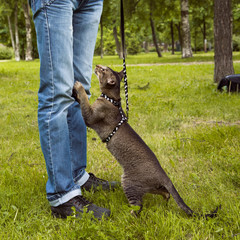
Simple Steps at the Very Beginning
If you still do not have a clicker or a training tool, you can try some basic training. By making a few simple steps you can train your cat to follow your finger. Prepare your cat’s favorite treats and put a small piece next to him/her (a few feet away). Repeat this step until your cat starts actively searching for a treat. As a next step you should start pointing your finger at the treat to indicate its position. Your cat will start associating your finger with the treat’s location. As a next step you should point your finger at a certain spot on the ground, pretending that there is a treat. Once your cat approaches your finger, you should say a cue word (according to your preferences and do not change it) and give your kitty the treat that you hold and hide in the same hand. The next step is to gradually change your finger’s position by raising it a little. This step is important especially if you want to train your cat the “High Five” command in the future. Once your cat approaches your finger while it is a few centimeters from the ground, say the cue word and reward him/her.
At this point you should be able to make your kitty follow your finger even if it keeps moving, i.e. move your finger from left to the right and let your kitty follow it. Then repeat the well-known step- say the cue word and give a treat. You can also add some sort of obstacles- a small object or your leg, that your cat will need to jump over to reach your finger. It is important that you repeat each step several times prior to moving to the next one.
Train Your Cat To Use a Litter Box
Cats have the natural instinct to bury their waste, and they learn quite quickly to use a litter box. If your cat has not developed a habit to use a litter box yet, you can encourage him/her to do it. Make sure that the litter box is clean and placed in a quite and easy accessible place, but not right next to his/her food and water bowl. Do not use any strong artificial fragrances that may repelled your cat. To encourage your kitty to use the litter box you can gently rub his/her front paws in the sand, after her/she has eaten and/or drank water. Your kitty should figure out the purpose of the liter box soon. If he/she needs additional motivation at the beginning, you can reward him/her right after he/she finished their business in the litter box. Never punish your kitty if he/she relieves him/herself outside the litter box. Punishment will not help you teach your cat what to do.
Crate Training a Cat
At the beginning you should reward your cat even for the simplest interest on their part towards the crate, i.e. when your cat looks at the crate, or just sniffs around. Gradually you should raise the requirements and start rewarding him/her for approaching the crate, and actually going in it voluntarily. You can also motivate your paw friend to enter the crate by putting treats inside. Once you notice that your cat feels comfortable inside, you can close the door for several seconds. At the beginning keep the door closed for 2-3 seconds only and increase the duration gradually. When you notice that your kitty remains calm and comfortable, you can try lifting up the carrier for a few seconds. Then put it back on the ground. Reward your cat when he/she remains calm. Soon you should be able to bring him/her for regular veterinarian checks in a crate without problems.
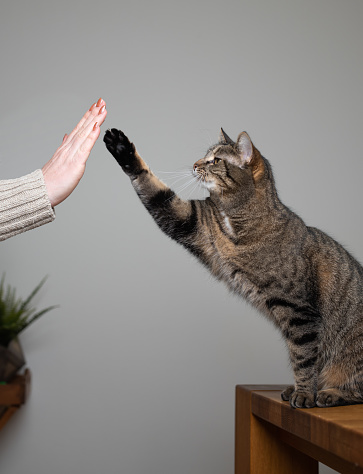
Train Your Cat to Give a High Five
As a first step you should prepare your cat’s favorite treats and hold them in a closed fist near to the ground. If your cat paws you, say “Yes” or another word and give them a treat. Repeat the step several times. Lift your hand with a few inches. Once your paw friend touches your hand, say “Yes” or the chosen word and reward them. Increase the height step by step so that your kitty will need to reach out higher to get the treat. After your kitty has performed this behavior several times, you can start using “high five” as cue words to mark the behavior. After several repetitions to ensure that your kitty has mastered the behavior, you can change the position of your hand- open your palm so that it meets your kitty’s paw when he/she tries to touch it. Say “high five”, when your cat touches your palm, then say “yes” and give him/her a treat.
Train a Cat to Come on Command
In order to train your cat to come on command, you should start using a certain word or a noise right before feeding, i.e., before you open a can, say a word/ click with a clicker or with your tongue or otherwise create a distinctive sound. Your kitty is likely to start pairing the produced sound with food (the strongest motivator for cats) and eventually will start coming to you, when he/she hears it. At the beginning you should motivate your cat to come to you within the training sessions and keep a short distance. Gradually you should reinforce this behavior outside the feeding time. Produce the special sound, that you want your cat to associate with a reward, then click, when your cat comes to you, to mark the behavior, and give him/her a treat. Remember to keep the sessions short- no longer than 4-5 minutes and make several repetitions (15-20 times) during each session (2-3 sessions a day).
Train Your Cat to Sit
As I explained in the article “Cat Clicker Training”, you can use two methods when applying clicker training: you can lure your cat to perform a certain behavior using treats as a primary motivator, i.e. hold the treat above your cat’s head. He/she may not want to loose it out of sight. Hence he/she is likely to sit in order to be able to follow the treat above his/her head with eyes. The second method is the “capturing” method, based on your cat’s natural behavior. You need to monitor your cat and wait for him/her to sit. Then you should mark the behavior (through a clicker or a voice command) and give them a reward. Both methods have their advantages and disadvantages- the first one is likely to bring quick results. However, you should be careful and not let your feline friend understand your intentions to manipulate his/her behavior. The second method requires more time, however, by using it you encourage your cat to perform a behavior, that is natural for him/her.
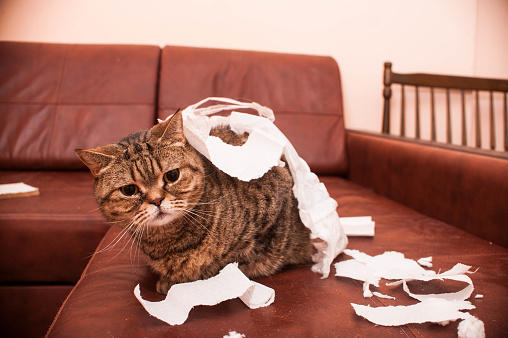
How to Address Bad Behaviors
Scratching furniture
There might be different reasons, causing your cat to scratch your furniture- scratching could be considered a sort of exercising for your cat, as it offers him/her the opportunity to stretch his/her muscles. Also, scratching helps cats remove the outer area of the claws, so that the sharp part beneath can show up. Your kitty may want to scratch a certain area to leave his/her pheromones on it and mark it as his/her territory. However, scratching may be related to attention seeking or anxiety. There are various factors that may cause anxiety in your cat such as moving in a new home, rearranging the furniture (any changes in his/her surroundings in general), welcoming a new pet or a baby, leaving the cat home alone for many hours...etc. Cats can be very sensitive to any changes that disrupt their routine. If you do not have any reasons to think that your cat is anxious and he/she behaves normally (no changes in the feeding habits or in the activity level), then scratching may be just a normal part of his/her typical daily routine. If this is the case, the best thing you can do is to provide your cat with a replacement. There are many scratching posts and plates on the market, with different shapes and surfaces. The first thing you should do is to monitor your cat and determine why he/she seems to prefer a certain furniture- what are its: shape, surface (how robust it is), location, height...etc. After you have answered all these questions, you should be able to evaluate what scratching post will suit your cat’s needs the most. Place it in an area where your cat often spends his/her time and encourage him/her to use it. In order to do that, you can add feathers, or toys on a string, that may awake your kitty’s interest. A further option is to apply cat pheromones (they are usually offered as sprays) on the scratching post’s surface. The scent will lure your cat and he/she is more likely to show interest in the post. If your cat continues showing a high interest in the furniture instead of the accessories designed for that, you can try to clean the furniture very well to remove any cat’s pheromones left on it.
There are cat scratching deterrents on the market, that give off a strong smell often unpleasant for both humans and cats. However, it is usually recommended that the product will be applied several times to be effective. If you are not into these types of products and prefer more natural ways to cope with the issue, there is an another option available- you can put a double-sided adhesive tape on the furniture’s surface. It will change the feeling your cat has when scratching it. It will not injure your cat in any way, but it will create an unpleasant feeling, since the surface has been changed. We would recommend that you do not buy too sticky tapes, as they can be harmful for your kitty’s paws and your furniture as well.
Train Your Cat to not Jump On Counter Tops
If you would like to prevent your kitty from jumping on counter tops, you should not yell at him/her and punish him/her. If your feline friend already knows the “sit” command, this is the moment for you to use it! Let your kitty take a sitting position and reward him/her immediately. The great feeling that will come after receiving delicious treats will drastically reduce his/her desire to access forbidden areas or do anything else (unless food is included). Also, you can apply the trick from the previous point- put a double-sided adhesive tape on the surface of the counter top. Since the surface has changed, your kitty is not likely to have such a great feeling when on the top of it.

Prevent Your Cat from Chewing
Chewing can be potentially dangerous for your cat, especially if he/she is interested in chewing cables or electrical tools. The first option to address this behavior is to redirect your cat’s attention to items that he/she is allowed to chew- chewing toys or sticks. If the issue persists, you can spray the surface of the cables and all items dangerous for your paw friend with a deterrent spray with a bitter taste (apple, cherry...etc). The spray will discourage your kitty from chewing certain objects by leaving a bad taste in his/her mouth.
Prevent your Cat from Kicking and Biting
This behavior may occur if you cross some boundaries and violate your cat’s privacy. You should always respect your cat’s personal space. Do not try to pet him/her too rough and for too long or interact with him/her when he/she is engaged in another activity, that seems more interesting for him/her at that time.
If your kitty gets caught up in playing and starts biting or kicking, you should discourage him/her by ignoring him/her. Stop playing with him/her, until he/she calms down. When your kitty gets calm, you can reward him/her. Also, you can put your kitty’s favorite treat in your hand and let him/her lick it. That way your meowing friend will learn to be more gentle with your hand.
Prevent Your Cat from Eating Plants
Some houseplants could be toxic for your cat, so you should be very careful if your kitty has developed the bad habit to eat them. You can either avoid buying such houseplants or putting them in a separate area in your home, where your cat is not allowed. Just like we explained in the steps above, you can put a double-sided tape or a foil to cover them and reduce your kitty’s interest towards them.
Prevent Your Cat from Begging for Food
Cats and dogs are likely to whine, yowl and use any type of vocalization to manipulate us for food. If you have a greedy kitty that is constantly meowing for food, the best thing you can do is to ignore her/him
Whether training a dog or a cat, every beginning can be hard. We need to be patient and loving towards our paw friends if we want to achieve the desired results.












